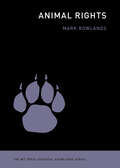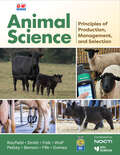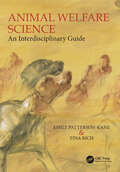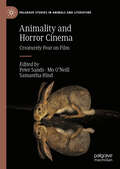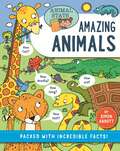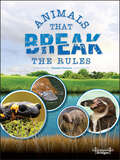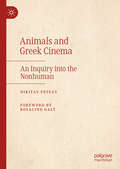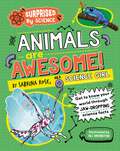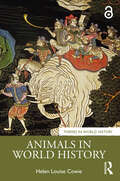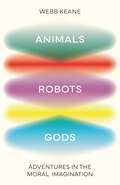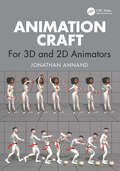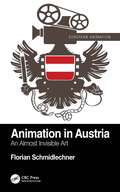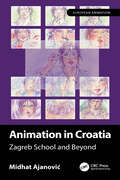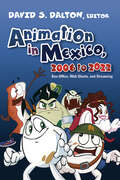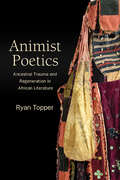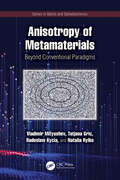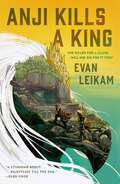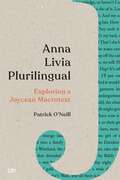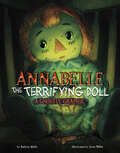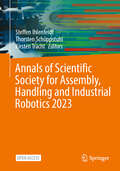- Table View
- List View
Animal Rights (The MIT Press Essential Knowledge series)
by Mark RowlandsA fresh view of animals and what we owe them.Do animals have moral standing? Do they count, morally speaking? In Animal Rights, Mark Rowlands argues that they do and explores the implications of this idea. He identifies three different waves in animal rights writing. The first wave was defined by a traditional dispute between utilitarianism (represented by Peter Singer) and rights-based approaches (represented by Tom Regan) to ethics. The second wave was defined by an expansion in a conception of ethics, which saw utilitarian and rights-based approaches supplemented by other ethical traditions, including contractualism, virtue ethics, and care ethics. The third wave was defined by an expansion in our conception of animals, driven by exciting new developments in the field of comparative psychology.Each of these waves had ramifications for how we understand the moral status of animals, but, this book argues, and reinforces, the core idea that animals deserve moral respect. In earlier waves, discussions of animal ethics had been focused on the issue of animal suffering. But the third wave is defined by the idea that animals are far more than merely sufferers or enjoyers of experiences but are instead authors of their own lives: creatures capable of choosing how to live, shaped by a conception of their life and how they would like it to go. Rowlands writes that, no matter what moral theory you choose, the most plausible version of that theory entails that animals have moral standing and that our obligations to them are far more substantial than many of us care to acknowledge.
Animal Science: Principles Of Production, Management, And Selection
by John S. Rayfield Kasee L. Smith Jeremy Falk Kattlyn Wolf Allen Pettey Drew Parks Benson Jessica Fife Noe Alberto GomezAnimal Science: Principles of Production, Management, and Selection introduces students to the important scientific and applied concepts within the global and domestic animal industries. Serving as an in-depth and hands-on resource for animal science courses, it begins by covering the basics of animal science, including careers, anatomy and physiology, animal health and nutrition, genetics, reproduction, scientific methods, products, and by-products, as well as current issues facing animal scientists. It proceeds with animal-specific sections on beef cattle, swine, sheep, goats, dairy cattle, equine, poultry, and companion animals, each with chapters covering the industry, production, management and care, selection and evaluation, and classification and breeds. Written by an outstanding team of authors who are all current educators with a long history in the animal science industry, this text is up-to-date, well-organized, and extremely image rich with modern, high-quality photos and diagrams. Special features include Before You Read, Did You Know?, Hands-On Animal Science, Safety Notes, Ag Ed Connections, Career Connections, and STEM Connections. It will also serve as a resource and learning tool for programs that don't have a school farm.
Animal Welfare Science: An Interdisciplinary Guide
by Emily Patterson-Kane Tina RichAnimal welfare as a concept and practice is important to many disciplines and professions. From blue skies scientists to front line animal rescue, there is a need for this textbook, which distils and interprets the core concepts and language of animal welfare science.Coverage includes the main theories and why we needed them; practical advice for how to assess animal welfare; illustrative examples of different species and the importance of their interactions; and the stresses and strains experienced across an increasingly diverse workforce. Foundational knowledge is combined with real-world examples and recent advances to communicate the content and spirit of this unique field.This accessible text is designed to support tertiary animal welfare curricula but is also relevant to the study of human–animal interactions, anthropology, and related fields. It provides a jumping-off point for many areas of knowledge and application for anyone interested in how animal welfare and science intersect. Animal Welfare Science: An Interdisciplinary Guide was created to provide an informational grounding that fosters competency, credibility, and the confidence to engage with peers across the animal welfare space. It also provides an overview of the career landscape with practical advice about the challenges and pressure points that you may encounter. Along with copious color illustrations, bullet points, text boxes, thought experiments, tables, and links to video and other online resources aid accessibility.
Animal, Vegetal, Marginal: The German Literary Grotesque from Panizza to Kafka (German Jewish Cultures)
by Joela JacobsBetween the Kaiser's and Hitler's Reichs, the genre of die Groteske, or the German literary grotesque, sold out cabarets, drew droves of radio listeners, and created bestsellers with its irreverent comedy and critique. At the same time, its authors were ruthlessly censored for their satire of society, leaving die Groteske virtually unknown today.As the first full-length study of the genre, Animal, Vegetal, Marginal recovers this short prose form, which draws on the perspectives of marginalized animals, plants, and individuals to challenge what it means to be human. Author Joela Jacobs traces the development of the genre and its variations from the work of Oskar Panizza, Hanns Heinz Ewers, and Salomo Friedlaender to Franz Kafka.Animal, Vegetal, Marginal shows how marginalized and nonhuman voices mounted resistance against the rise of the biopolitical structures underpinning nationalism, racism, and antisemitism in the decades leading up to the Second World War.
Animality and Horror Cinema: Creaturely Fear on Film (Palgrave Studies in Animals and Literature)
by Peter Sands Samantha Hind Mo O’ NeillAnimality and Horror Cinema provides a wide-ranging overview of the role played by animals in the genre of horror cinema. Across four sections that unite affective and generic modes of horror with animals, animality, and the discourse of species, the volume demonstrates the multivalent operation of animality in transnational cinemas that look beyond the trope of monstrous adversity associated with the creature feature. With chapters focusing on the extrusion of animals from horror narratives, the multisensorial dimensions of animal horror, the intrusion of documentary violence, and the horrific contiguity of human and nonhuman flesh, it argues for the concept of creaturely fear as a lens through which to read horror&’s blurring of the species barrier. The collection appeals to those interested in the intersection of animal and film studies with memory studies, afropessimism and critical race theory, posthumanism, biopolitics, ecocriticism, queer theory and vegan theory.
Animals (Animal Stats)
by Simon AbbottDo you think you're an animal expert? Get the stats on the BIGGEST, the smallest, the fastest, the LOUDEST and much more!Packed with fascinating facts, stats and data, curious kids will be amazed to learn about the millions of animal species that share our planet, as well as habitats, animal adaptations and how to help our planet's biodiversity. Simon Abbott's fun characters draw in curious minds by answering the science and numeracy questions kids want to know, with the super-impressive answers found in nature!The Animal Stats series features accessible text paired with bright, colourful artwork, ideal for readers aged 6+, and includes a creature quiz at the back of the book to test their knowledge. Other titles in the series include Minibeasts, Sea Life and Dinosaurs.
Animals That Break the Rules (Nature's Rule Breakers)
by VizcarraDid you know there are critters that are powered by the sun, mammals that lay eggs, and penguins with pink poop? What are these rule-breaking animals? Why do they do what they do? Be a critter detective and find out by digging into this Animals That Break the Rules Animal Book! Part of the Nature’s Rule Breaker’s Children’s Book Series, this 32-page nonfiction book explores strange animal species that are fascinating and fun with fun-filled facts and vibrant photos that will prove just how unique these animals really are!Science Books for Kids Ages 8-12 Features:Comprehension questionsExtension activitySupports NGSS standardsAbout Rourke Educational Media:We proudly publish respectful and relevant nonfiction and fiction titles that represent our diverse readers, and are designed to support reading on a level that has no limits!
Animals and Greek Cinema: An Inquiry into the Nonhuman
by Nikitas FessasThis book offers a non-anthropocentric account of a national cinema. Drawing on cutting-edge developments in Animal (film) studies, the book gathers a wide range of species and genres to discuss the Greek cinematic animal. This en-tails recalibrating the readers&’/viewers&’ gazes to include particular nonhumans, often displaced in the frame&’s margins. While acknowledging the cost paid in animal suffering for Greek cinema to rise, the book features instances of animal-human bonding. Combining close readings with interviews with directors, human actors, screenwriters, cinematographers, producers, special effects artists, and animal wranglers, this book proposes a paradigm of human-animal praxis, arguing that revisiting nonhuman images can lead to renewed ethical relations, and to less speciesist cinemas, film industries, and societies.
Animals are Awesome! (Surprised by Science #1)
by Sabrina Rose Science GirlBe surprised by the astonishing science of the animal kingdom, with Sabrina Rose, AKA Science Girl, the internet's most inspiring curator of facts and observations of our wonderful world - making it easy for all readers to come to love science!Surprised by Science: Animals are Awesome brings an attention-grabbing and accessible set of animal facts to life! Doing what she's famous for online, Sabrina Rose dives into the most surprising corners of the animal world to explore the science at work. From adorable and unlikely friendships, to uninvited parasites; from animal impressionists to record-breaking lifespans - this series is perfect for inquisitive children age 7 and up, and all fans of Science Girl.Surprised by Science is a series of books that takes the inspiring communication and research skills of Science Girl's hugely popular platform and distills it on the page, with funny and engaging illustrations by Ali Ardington paired with photos of the real-life science in action. The series includes: Electricity is Epic!; Plants are Powerful!; Forces are Fantastic!; Sound is Sensational!; Animals are Awesome!; Human Bodies are Brilliant!
Animals in World History (Themes in World History)
by Helen Louise CowieThis volume provides a concise synthesis of human-animal relations over time, charting shifting attitudes towards animals from domestication to the present day. It asks how non-human species have shaped human history, and how humans have reconfigured the animal world.Humans have had a long and close relationship with animals. They have hunted them, consumed them as food and fashion, exploited them as energy sources, utilised them in warfare, exhibited them in zoos and menageries, and studied them for science. In the process, they have radically changed the way in which many animals live, subjecting them to captivity, altering their diets, constraining their movements and, through selective breeding, reshaping their bodies. The book explores the use of animals for sustenance, labour, companionship and display, and traces the rise of the animal rights movement. It also assesses how humans have impacted the overall biodiversity of the planet, driving some species of animals to extinction and permitting others to colonise new continents. With case studies on animal astronauts, celebrity kakapos, globetrotting pandas and cocaine hippos, Animals in World History offers a lively and accessible introduction to human-animal relations for students and instructors of animal studies, environmental history, and social and cultural history.
Animals of the National Parks: An Alphabet Book
by Fifty-Nine ParksFor nature lovers of any age, this book is a beautiful A-to-Z introduction to the wild and wonderful animals that live in America's national parks. Featuring art from the beloved printmakers and poster illustrators at Fifty-Nine Parks.America's national parks are some of the most magical places in the world, and home to a diverse array of creatures, both well known and more unusual. From American Bison (which are also the largest mammals in the parks) to flying squirrels (which can glide the length of a football field) to Xeme (which take two full years to grow their adult feathers), this picture book takes children on an enchanting alphabetical adventure through the natural world.The book features fascinating facts about each animal, including information on where they can be found. A passport page to record visits and an illustrated map of all the national parks will encourage children and their families to make the most of every trip. With beautifully evocative art that's nostalgic yet contemporary, this is a special gift for outdoor and national park lovers of all ages.
Animals, Empathy, and Anthropomorphism: The Limits of Imagination (The Palgrave Macmillan Animal Ethics Series)
by Carlo SalzaniThis open access book explores the role of imagination in animal ethics and its constitutive links to empathy/sympathy and anthropomorphism. The book argues for the constitutive role of imagination in ethical deliberation, but acknowledges that there exist important limits to its use. However, &“limit&” is here understood not merely negatively as restriction and insufficiency, but rather positively as &“condition of possibility,&” so what the book explores and analyses are the conditions for a positive and fruitful use of the imagination in ethics. The book uses as a &“frame&” the questions and issues raised in J.M. Coetzee&’s The Lives of Animals to explore some central and salient themes.
Animals, Robots, Gods: Adventures in the Moral Imagination
by Webb KeaneA mind-expanding exploration of the ethical bonds we share with the nonhumanMoral relationships saturate the living world, and the line between the human and nonhuman is blurrier than we might think. Animals, Robots, Gods provides a bold new vision of ethics defined less by the individual mind or society and more by our interactions with those around us, whether they are the pets we keep, the gods we believe in, or the machines we endow with life.Drawing on pioneering fieldwork around the globe by some of today&’s leading researchers, acclaimed anthropologist Webb Keane invites us to expand our moral imagination. We learn about the ethical dilemmas of South Asian animal rights activists, Balinese cockfighters, cowboys, and Japanese robot fanciers. We meet a hunter in the Yukon who explains to a bear why it must come out of hibernation and generously give itself up to him, a cancer sufferer in Thailand who sees his tumor as a reincarnated ox, and a computer that persuades users to confess their anxieties as if they were patients on a psychiatrist&’s couch. Through these and other stories, Keane challenges us to rethink our most basic ideas about who—and what—we deem worthy of moral consideration.Brimming with charm, wit, and insight, Animals, Robots, Gods reveals how centuries of conversations between us and nonhumans inform our conceptions of morality and will continue to guide us in the age of AI and beyond.
Animating the Victorians: Disney's Literary History (Children's Literature Association Series)
by Patrick C. FlemingMany Disney films adapt works from the Victorian period, which is often called the Golden Age of children’s literature. Animating the Victorians: Disney’s Literary History explores Disney’s adaptations of Victorian texts like Alice in Wonderland, Oliver Twist, Treasure Island, Peter Pan, and the tales of Hans Christian Andersen. Author Patrick C. Fleming traces those adaptations from initial concept to theatrical release and beyond to the sequels, consumer products, and theme park attractions that make up a Disney franchise. During the production process, which often extended over decades, Disney’s writers engaged not just with the texts themselves but with the contexts in which they were written, their authors’ biographies, and intervening adaptations. To reveal that process, Fleming draws on preproduction reports, press releases, and unfinished drafts, including materials in the Walt Disney Company Archives, some of which have not yet been discussed in print. But the relationship between Disney and the Victorians goes beyond adaptations. Walt Disney himself had a similar career to the Victorian author-entrepreneur Charles Dickens. Linking the Disney Princess franchise to Victorian ideologies shows how gender and sexuality are constantly being renegotiated. Disney’s animated musicals, theme parks, copyright practices, and even marketing campaigns depend on cultural assumptions, legal frameworks, and media technologies that emerged in nineteenth-century England. Moreover, Disney’s adaptations influence modern students and scholars of the Victorian period. By applying scholarship in Victorian studies to a global company, Fleming shows how institutions mediate our understanding of the past and demonstrates the continued relevance of literary studies in a corporate media age.
Animation Craft: For 3D and 2D Animators
by Jonathan AnnandThis book is for those who want to learn the craft or mechanics of animation, how to actually animate a scene from start to finish, or take their animation to the next level. Using over 600 examples, this book answers the questions about the craft of animation that are often not taught in schools or books.Each chapter contains step-by-step examples explaining the principles of animation and how to avoid common problems that occur when animating. This book also teaches you how to critique an animated scene objectively, rather than subjectively — then fix what’s wrong with it.Animation Craft for 3D and 2D Animators will be a great resource for any beginner looking to learn the fundamentals of animation, or more experienced animators looking to hone their craft.
Animation in Austria: An Almost Invisible Art (European Animation)
by Florian SchmidlechnerThis book provides a comprehensive account of Austrian animation history, as well as an analysis of the current state of the industry in competition with American and cheaper international products in the face of dwindling budgets.The book outlines the history of Austrian animated film from the actual beginnings at the time of the First World War. It looks at the reconstruction of the animation industry during the 1950s and 60s and covers experimental animation from the 1970s onwards. The final part of the book explores modern Austrian animation and looks ahead to the future of animation production within the country.This book will be of great interest to academics, students, and professionals working and researching in the field of animation.
Animation in Croatia: Zagreb School and Beyond (European Animation)
by Midhat AjanovićThis book provides a comprehensive account of Croatian animation history, as well as an analysis of background factors such as political and social circumstances and cultural heritage that influenced the great international success of Croatian animators between the 1960s and 1980s. The book focuses on the history of the Zagreb School of Animated Film, which produced dozens of extremely significant animated films between the 1960s and 1980s, which constituted an important epoch in the development of film animation as an artistic form. It provides a case study of three important films: Dnevnik by Nedeljko Dragic, Don Kihot by Vladimir Kristl and Koncert za masinsku pusku by Dusan Vukotic. The book also covers modern Croatian animation developed after the independence of the country.This book will be of great interest to academics, students and professionals working and researching in the field of animation.
Animation in Mexico, 2006 to 2022: Box Office, Web Shorts, and Streaming (SUNY series in Latin American Cinema)
by David S. DaltonExamines contemporary animation in Mexico—one of the most commercially successful and most understudied genres of the national cinema.Answering a call to view Mexican film through the lens of commercial cinema, Animation in Mexico, 2006 to 2022 is the first book-length study of the country's animated cinema in the twenty-first century. As such, the volume sheds light on one of the country's most strategically important and lucrative genres, subjecting it to sustained intellectual analysis for the first time. Building on earlier film history, David S. Dalton identifies two major periods, during which the focus shifted from success at the national box office to internationalization and streaming. In eight original essays, contributors use an array of theoretical and disciplinary approaches to interrogate how this popular genre interfaces with Mexican politics and society more broadly, from Huevocartoon to Coco and beyond. The book will appeal to students, scholars, and fans of Mexican film by situating animation within broader currents in the field and the industry.
Animist Poetics: Ancestral Trauma and Regeneration in African Literature (SUNY series, Philosophy and Race)
by Ryan TopperArgues that African literature conceptualizes trauma and regeneration as a more-than-human process, offering an animist revision of psychoanalysis.Psychoanalytic trauma theory largely disregards African perspectives. Postcolonial criticism often filters these perspectives through a secular humanist lens. Examining how African literature uses animism to address the traumas of colonization, Animist Poetics offers a new understanding of the postcolonial condition. From an animist viewpoint, the self is not an individual but rather a regenerative process linking the living, the dead, and their ecosystems. Looking at poetry, fiction, drama, and visual art—including archival manuscripts by Wole Soyinka and Yvonne Vera—Ryan Topper argues that African literature reinvents these Indigenous ecologies in uniquely modern ways. Animist Poetics takes Indigenous—and literary—knowledge seriously, rethinking the foundations of psychoanalysis and charting new theoretical paths in posthumanism, the environmental humanities, new materialism, biopolitics, and memory studies.
Anisotropy of Metamaterials: Beyond Conventional Paradigms (Series in Optics and Optoelectronics)
by Vladimir Mityushev Natalia Rylko Tatjana Gric Radoslaw KyciaAnisotropy of Metamaterials: Beyond Conventional Paradigms provides a comprehensive introduction to the mathematical modeling of metamaterials based on the macroscopic complex-valued permittivity tensor of dispersed random composites. Key topics include physical and mathematical theory, computer simulations, constructive homogenization, classification of dispersed random composites and their applications in cancer recognition. Image processing and machine learning algorithms are used. The book also discusses the precision of various effective medium approximations, including Bruggeman and Maxwell-Garnett formulas. New analytical, approximate and exact formulas and bounds for the macroscopic permittivity and piezoelectric constants of composites are derived. This book is a valuable tool for academics and professionals in photonics, presenting sustainable materials for sensing, health diagnostics and cancer detection methodologies.Key features: Offers key insights into the current trends and techniques in the study of the macroscopic properties of metamaterials, aiming at stimulating new avenues of research Presents examples of image analysis, the primary tool for non-destructive metamaterials analysis Discusses the applications of Machine Learning to image processing, illustrated using specific code in Python programming language
Anjali Can! (Always Anjali)
by Sheetal ShethAnjali is back and ready to prove there&’s nothing she can&’t do, in this third book in the Always Anjali series! When a beloved community center is threatened with shutting down, Anjali must quickly find a way to save the space or risk losing it.The local community center is a second home to Anjali. It's where she met her best friends; it's her favorite spot for game and movie nights; and it's where she learned to play tabla.Anjali has so many happy memories there, but now the community center is closing! Unwilling to let the center shut down for good, Anjali is determined to keep the place open. Some people may say there's nothing she can do, but Anjali knows better--she can and must take action! There is no stopping her.From actor, author, and activist Sheetal Sheth comes the third book in the Anjali series and a reminder of the power of one and to always fight for what you believe in.
Anji Kills a King (The Rising Tide)
by Evan LeikamAn unlikely assassin struggles to escape a legendary bounty hunter in this breakneck fantasy debut that will grab you by the throat—perfect for fans of Joe Abercrombie, R.F. Kuang, and Christopher Buehlman.She killed for a cause. Will she die for it too?Anji works as a castle servant, cleaning laundry for a king she hates. So when a rare opportunity presents itself, she seizes the chance to cut his throat. Then she runs for her life. In her wake, the kingdom is thrown into disarray, while a bounty bigger than anyone could imagine lands on her head.On her heels are the fabled mercenaries of the Menagerie, whose animal-shaped masks are magical relics rumored to give them superhuman powers. It’s the Hawk who finds Anji first: a surly, aging swordswoman who has her own reasons for keeping Anji alive and out of the hands of her fellow bounty hunters, if only long enough to collect the reward herself.With the rest of the Menagerie on their trail, so begins an alliance as tenuous as it is temporary—and a race against death that will decide Anji’s fate, and may change the course of a kingdom.At the Publisher's request, this title is being sold without Digital Rights Management Software (DRM) applied.
Anna Livia Plurilingual: Exploring a Joycean Macrotext
by Patrick O'NeillThe complexity of James Joyce’s Finnegans Wake ensures that it cannot be translated; rather, it can only be rewritten. These rewritings vary significantly, and the extent of their differences – both within individual target languages and across multiple languages – invites further exploration.Anna Livia Plurilingual is a study of a Joycean macrotext that provides a detailed comparative analysis of multiple translations of selected excerpts from Joyce’s iconic Anna Livia Plurabelle (1928), which was later incorporated into Finnegans Wake (1939). Patrick O’Neill examines how these translations function as independent texts rather than mere derivatives of the original, highlighting the creative and interpretative choices made by translators.While the concept of a literary macrotext could in principle encompass all reader responses, this work specifically focuses on translations, emphasizing comparative readings of the original text alongside its diverse interpretations. O’Neill’s investigation not only illuminates the intricacies of Joyce’s language and the complexities of the resulting macrotext but also offers valuable insights into the broader field of literary translation studies.
Annabelle the Terrifying Doll: A Ghostly Graphic (Ghostly Graphics Ser.)
by Andrew WolfeIn 1970, a nursing student was given a large doll as a gift. Soon, the doll—which became known as Annabelle—began acting strangely. When no one was looking, Annabelle changed positions on its own. Then the doll began leaving creepy, cryptic notes asking for help. Was Annabelle possessed by the spirit of a dead girl? Or was the doll an anchor for a demon? Young readers will find out in this easy-to-read ghostly graphic novel that will send shivers down their spines!
Annals of Scientific Society for Assembly, Handling and Industrial Robotics 2023
by Thorsten Schüppstuhl Kirsten Tracht Steffen IhlenfeldtThis open access book presents a good overview of the current research landscape of assembly, handling and industrial robotics. The objective of MHI Colloquium is the successful networking at both academic and management levels. Thereby, the colloquium focuses an academic exchange at a high level in order to distribute the obtained research results, to determine synergy effects and trends, to connect the actors in person and in conclusion, to strengthen the research field as well as the MHI community. In addition, there is the possibility to become acquainted with the organizing institute. Primary audience is formed by members of the scientific society for assembly, handling and industrial robotics (WGMHI).
